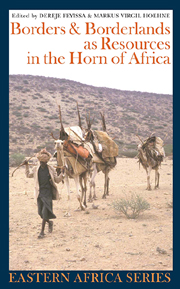Book contents
- Frontmatter
- Contents
- List of Maps, Tables & Charts
- Preface by Günther Schlee
- Editors' Preface
- Notes on Contributors
- List of Acronyms
- 1 State Borders & Borderlands as Resources
- 2 More State than the State?
- 3 Making Use of Kin beyond the International Border
- 4 The Tigrinnya-speakers across the Borders
- 5 Trans-Border Political Alliance in the Horn of Africa
- 6 People & Politics along & across the Somaliland-Puntland Border
- 7 The Ethiopian-British Somaliland Boundary
- 8 The Opportunistic Economies of the Kenya-Somali Borderland in Historical Perspective
- 9 Magendo & Survivalism
- 10 Can Boundaries not Border on One Another?
- 11 Conclusion
- Index
- EASTERN AFRICAN STUDIES
9 - Magendo & Survivalism
Babukusu-Bagisu Relations & Economic Ingenuity on the Kenya-Uganda Border 1962–80
Published online by Cambridge University Press: 05 April 2013
- Frontmatter
- Contents
- List of Maps, Tables & Charts
- Preface by Günther Schlee
- Editors' Preface
- Notes on Contributors
- List of Acronyms
- 1 State Borders & Borderlands as Resources
- 2 More State than the State?
- 3 Making Use of Kin beyond the International Border
- 4 The Tigrinnya-speakers across the Borders
- 5 Trans-Border Political Alliance in the Horn of Africa
- 6 People & Politics along & across the Somaliland-Puntland Border
- 7 The Ethiopian-British Somaliland Boundary
- 8 The Opportunistic Economies of the Kenya-Somali Borderland in Historical Perspective
- 9 Magendo & Survivalism
- 10 Can Boundaries not Border on One Another?
- 11 Conclusion
- Index
- EASTERN AFRICAN STUDIES
Summary
Introduction
The issue of community relations across the Kenya-Uganda border can only be underscored within the specificity that appreciates both the international and domestic state-society dynamics defining its functionality. In regard to the specific relations between the Babukusu and the Bagisu peoples, it is not possible to restrict our analysis to conflicts. Both the Babukusu and the Bagisu communities who occupy western Kenya and eastern Uganda respectively have enjoyed a corporate past whose history transcends the current common Kenya-Uganda border. This past is manifested in the peoples’ common history of origin, migration and settlement in their present areas (La Fontaine 1960; Were 1967; Makila 1978; Wafula 2000, 2007). Besides similarities in language, semblances among these communities are found in such cultural aspects as codes of conduct, marriage customs, circumcision traditions and even folklore.
The historical dynamics defining the relations between the Babukusu and Bagisu have influenced the nature of their social, economic and political interactions between themselves and with other neighbouring communities that include the Bantu, Nilotic and Cushitic groups. As Makila (1978: 46) has aptly argued, in relation to the Babukusu, ‘if they are the Abaluyia1 by virtue of their geographical circumstance, they are first and foremost members of a duplex community incorporating the Bagisu by virtue of a historical circumstance.’ Throughout the pre-colonial, colonial and post-independence periods, the Babukusu and the Bagisu peoples have maintained a fluid cultural zone along the common Kenya-Uganda border that is mainly informed by their strong historical ties.
- Type
- Chapter
- Information
- Borders and Borderlands as Resources in the Horn of Africa , pp. 151 - 168Publisher: Boydell & BrewerPrint publication year: 2010



